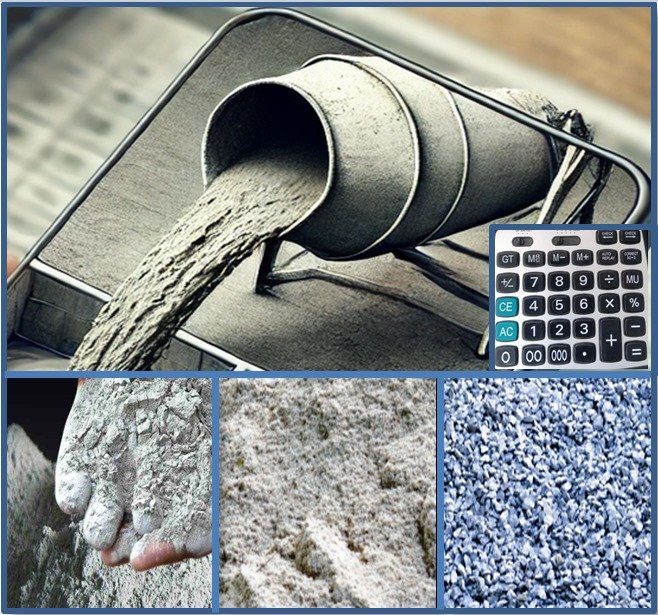Concrete Calculator: Cement, Sand and Aggregate Dry Quantities
Accurate calculation of Cement, Sand and Aggregate Dry Quantities is essential for producing high quality concrete. Whether you're a civil engineer, contractor or client, determining the right mix ratios is critical for success and Smooth running of project. Our Concrete Calculator simplifies this process by providing accurate estimates based on the concrete mix design, ensuring that your materials are efficiently and correctly proportioned.

How the Concrete Calculator Works
Our calculator uses standard concrete mix ratios based on the M-grade system, commonly referred to as M5, M7.5, M10, M15, M20, M25 and so on, where M denotes the mix and the number indicates the compressive strength of the concrete.
For example, the most common mix ratio used in construction is M20, which typically consists of 1 part cement, 1.5 parts sand, and 3 parts aggregate. The calculator will estimate the required quantities based on this ratio or any other custom mix ratio you input.
Inputs Required:
- Volume of Concrete: Enter the total volume of concrete you need (in cubic meters or cubic feet) or you can also enter the Dimensions (Length, Width, Height) of construction structure.
- Mix Ratio: Select or input the specific concrete mix ratio M5, M7.5, M10, M15, M20, or M25 (e.g., 1:2:4 cement: sand: aggregate).
Outputs Provided:
- Cement Quantity: The exact amount of cement needed in kilograms or bags.
- Sand Quantity: The volume of sand required, typically in cubic meters or cubic feet.
- Aggregate Quantity: The volume of coarse aggregate required.
Calculation of Cement, Sand and Aggregate Dry Quantities
To estimate the Cement, Sand and Aggregate Dry Quantities in a concrete mix, following steps and formulas can be applied. This process is crucial for ensuring the right proportions and materials are used for your project.
Formula for Dry Material Quantities
For a concrete mix design, the dry material quantities can be calculated using the mix ratio of the concrete and the total volume required. A common mix design for general-purpose concrete is M20 (1:1.5:3), which signifies:
- 1 part of cement
- 1.5 parts of sand
- 3 parts of aggregate
For any concrete mix, the general formula to calculate the dry material quantities is:
Total Dry Volume of Concrete = Wet Volume of Concrete × 1.54
1.54 is a constant used to convert the wet volume to dry volume (accounting for voids in sand and aggregates).
Step-by-Step Calculation Example
1. Calculate the Wet Volume of Concrete
The wet volume is the actual volume of concrete required for your project. Suppose you need 1 cubic meter (m³) of concrete.
Wet Volume = 1 m³
2. Calculate the Dry Volume of Concrete
The dry volume accounts for the additional volume of materials due to voids. It is calculated by multiplying the wet volume by a factor of 1.54.
Dry Volume = 1 m³ × 1.54 = 1.54 m³
3. Calculate the Quantities of Cement, Sand, and Aggregate
Using the mix ratio, you can now calculate the quantities of cement, sand, and aggregate.
a) Quantity of Cement
The cement quantity is calculated based on the total parts in the mix ratio. For an M20 mix (1:1.5:3), the sum of the mix ratio is:
1 + 1.5 + 3 = 5.5
Cement Quantity = (1/5.5) × Dry Volume
Cement Quantity = (1/5.5) × 1.54 = 0.28 m³
Now, convert this volume into bags of cement. The density of cement is 1440 kg/m³ and a standard bag of cement weighs 50 kg. Cement in kg = 0.28 m³ × 1440 kg/m³ = 403.2 kg Number of Cement Bags = 403.2 / 50 = 8.06 bags
b) Quantity of Sand
Based on its proportion in the mix ratio (1.5 parts in M20):
Sand Quantity = (1.5/5.5) × Dry Volume
Sand Quantity = (1.5/5.5) × 1.54 = 0.42 m³
To convert this to cubic feet: Sand in cubic feet = 0.42 × 35.32 = 14.83 ft³
c) Quantity of Aggregate
For the aggregate, based on 3 parts in the mix ratio (M20):
Aggregate Quantity = (3/5.5) × Dry Volume
Aggregate Quantity = (3/5.5) × 1.54 = 0.84 m³
To convert to cubic feet: Aggregate in cubic feet = 0.84 × 35.32 = 29.67 ft³
Water Cement Ratio
The amount of water required for the preparation of concrete is called the water-cement ratio, which typically ranges from 0.4 to 0.6.
Assuming a water-cement ratio of 0.5:
Water Quantity = Cement Quantity × Water-Cement Ratio
For this example:
Water Quantity = 403.2 × 0.5 = 201.6 kg (liters)
Summary of Calculation Results for 1 Cubic Meter of M20 Concrete:
- Cement: 8.06 bags (403.2 kg)
- Sand: 0.42 m³ (14.83 ft³)
- Aggregate: 0.84 m³ (29.67 ft³)
- Water: 201.6 liters
Benefits of Using Our Concrete Calculator
1. Accuracy: Avoid costly material overestimation or underestimation with precise quantity calculation.
2. Efficiency: Save time on manual calculations, reducing errors, and ensuring that your project is on track.
3. Cost-Effective: By knowing exactly how much material you need, you can manage costs and avoid unnecessary wastage.
4. Versatility: Suitable for a wide range of projects, from small home builds to large commercial sites, and allows custom input for unique mix ratios.
5. Convenience: Accessible online anytime, this tool provides instant results, whether you are on-site or in the office.
Why Accurate Concrete Mix Calculations Matter
In construction, concrete is a fundamental material, used for building foundations, columns, beams, slabs and lintels etc. To achieve the desired strength and durability, it is important to use the correct proportions of cement, sand and aggregate in your concrete mix. Using either too much or too little of any component can compromise the structural strength, increase costs and lead to wastage.
Importance of Correct Concrete Mix Ratios
The correct proportions of cement, sand and aggregate directly affect the strength, workability and durability of the concrete. Improperly mixed concrete can lead to:
- Structural Weakness: Inadequate cement content may cause cracks and low compressive strength.
- Excessive Shrinkage: Incorrect water content can cause shrinkage cracks as the concrete cures.
- High Material Costs: Overuse of cement can unnecessarily increase project costs.
Conclusion
Our Concrete Mix Quantity Calculator automates this entire process, allowing you to enter your required concrete volume and mix ratio to get precise estimates of cement, sand, aggregate, and water quantities. This ensures accurate planning, cost control and material management for your construction projects. Whether you're building a foundation, slab or column, this tool simplifies the task by helping you save both time and resources.

